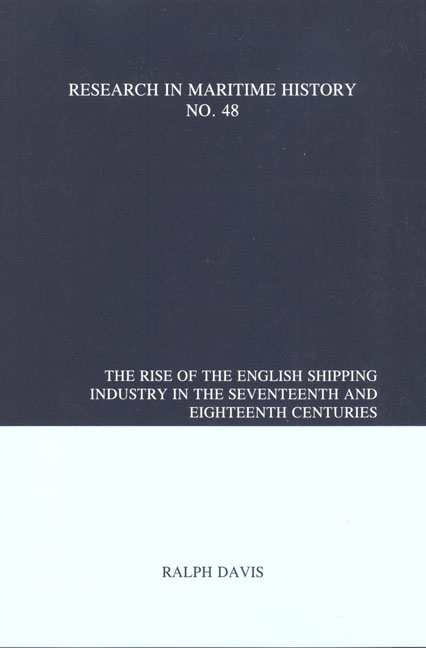Book contents
- Frontmatter
- Contents
- Introduction to the 2012 Edition
- Series Editor's Note
- Introduction
- Preface
- Chapter 1 The Widening of Horizons, 1560-1689
- Chapter 2 Consolidation, 1689-1775
- Chapter 3 Ships and Shipbuilders in the Seventeenth Century
- Chapter 4 Ships and Shipbuilders in the Eighteenth Century
- Chapter 5 The Shipowners
- Chapter 6 The Merchant Seamen
- Chapter 7 The Pay and Conditions of Merchant Seamen
- Chapter 8 Shipping Management and the Role of the Master
- Chapter 9 Shipping and Trade
- Chapter 10 The Nearby and Northern European Trades
- Chapter 11 The Southern European and Mediterranean Trades
- Chapter 12 The East Indian Trade
- Chapter 13 The American and West Indian Trades
- Chapter 14 The Government and the Shipping Industry
- Chapter 15 War and the Shipping Industry
- Chapter 16 Four Ships and Their Fortunes
- Chapter 17 Was It a Profitable Business?
- Chapter 18 Conclusion
- Appendix A A Note on the Shipping Statistics, 1686-1788
- Appendix B Sources for the History of the Shipping Industry
- Index
Chapter 9 - Shipping and Trade
- Frontmatter
- Contents
- Introduction to the 2012 Edition
- Series Editor's Note
- Introduction
- Preface
- Chapter 1 The Widening of Horizons, 1560-1689
- Chapter 2 Consolidation, 1689-1775
- Chapter 3 Ships and Shipbuilders in the Seventeenth Century
- Chapter 4 Ships and Shipbuilders in the Eighteenth Century
- Chapter 5 The Shipowners
- Chapter 6 The Merchant Seamen
- Chapter 7 The Pay and Conditions of Merchant Seamen
- Chapter 8 Shipping Management and the Role of the Master
- Chapter 9 Shipping and Trade
- Chapter 10 The Nearby and Northern European Trades
- Chapter 11 The Southern European and Mediterranean Trades
- Chapter 12 The East Indian Trade
- Chapter 13 The American and West Indian Trades
- Chapter 14 The Government and the Shipping Industry
- Chapter 15 War and the Shipping Industry
- Chapter 16 Four Ships and Their Fortunes
- Chapter 17 Was It a Profitable Business?
- Chapter 18 Conclusion
- Appendix A A Note on the Shipping Statistics, 1686-1788
- Appendix B Sources for the History of the Shipping Industry
- Index
Summary
So far we have been looking at shipping from the inside; at an industry attracting resources of enterprise, capital and labour to meet its needs. These needs depended, within the given technical framework, on the demands made by trade for the transport of goods, and the nature of these demands now calls for examination. The four chapters that follow discuss the varying demands made by individual branches of trade, and particular ways in which the shipping industry handled them. First, however, some more general problems of the relation between trade and transport must be considered, and the broad pattern of the industry's work set out.
It is essential, at the very beginning, to clear away the notion that the extent of the demand for transport can be judged by the statistics of trade - that is, trade as it is always recorded, valued in pounds, shillings and pence. To the shipowner, the two most important questions to be asked about a commodity have always been “How far is it to be carried?” and “How much does it weigh?” (or in some cases the alternative question “How much hold space will it occupy?”). As to the first of these, it is unnecessary to elaborate on the fact that carrying a thousand tons of goods a year from Newcastle to London created a far smaller demand for shipping than carrying the same tonnage from Jamaica to London; the former task employed one ship of 130 tons making eight voyages a year, but the latter required eight ships of this size because they could each make only a single voyage. Though the factor of distance seems obvious enough when put in this way, a deliberate effort to remember it must be made whenever the size of the English merchant fleet, or of the fleet owned at a particular port, is to be considered as distinct from the annual volume of goods it carried or the tonnage of entries and clearances of ships.
- Type
- Chapter
- Information
- The Rise of the English Shipping Industry in the Seventeenth and Eighteenth Centuries , pp. 169 - 194Publisher: Liverpool University PressPrint publication year: 2012

